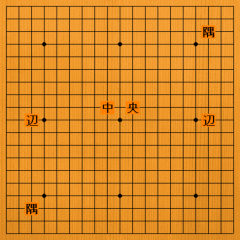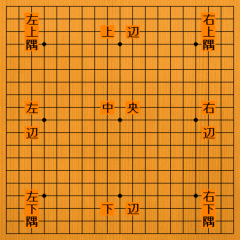 |
| Go is a game that you win by expanding your territory and getting more than the opponent. The size of your territory is calculated by adding up the number of intersections (points) you have surrounded on the board. Both sides try to expand their territories, but at the same time they also try to reduce the opponent's territories. The reason is that reducing the opponent's territory by ten points has the same value as increasing one's own territory by ten points. Because of this, various fights occur, making Go a complicated game. |
 |
[1]The 9x9 board and the 19x19 board

· The basic Go board is the 19x19 board.
· Dia. 1 shows the standard size. The names of the different parts of the board are self-explanatory: the corners, the sides, and the centre. |
 |

Dia. 1 |
|
· Let's look at Dia. 2. The centre remains the centre, but we can refer more specifically to the other parts of the board. For example, the left and right sides, the top, the bottom, the top right and bottom right corners and the top left and bottom left corners. |
 |

Dia. 2 |
|
· At the start, it's easier to study with a 9x9 board, as shown in Dia. 2. Compared to the 19x19 board, it's quite small. That limits the places you have to think about, so it's convenient for beginners. Because it's narrow, the stones of the two sides immediately come into contact. Black's first move is shown as a stone with 1 printed on it, and White's succeeding move is shown as White 2. In the game, White 4 comes into contact with Black 1. Black 5 and White 6 are intertwined with each other. The immediate start of violent fighting is a feature of the 9x9 board. |
 |
Dia. 3
|
|
 |